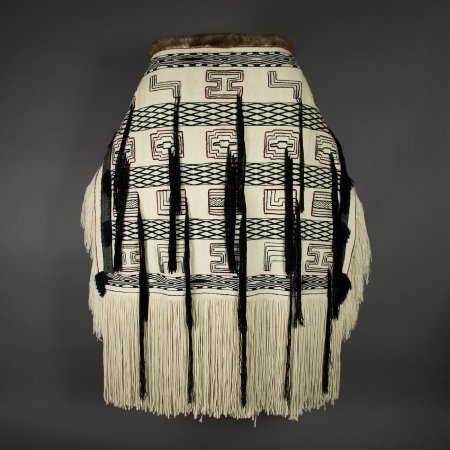Description:
Mother Robe
Ravenstail weaving is known to the Tlingit as yéil koowú. Named for a resemblance to the tail of a raven, this style predates Chilkat weaving. Traditionally, women designed and wove these ceremonial dance robes from mountain goat wool. Strips of cedar bark are woven in to provide structure. Ravenstail twining technique features geometric patterns, which are similar to spruce root basketry. The revival of the Ravenstail style was spearheaded by weaver Cheryl Samuel from an intensive study of the few known robes and fragments scattered around the world. After deciphering the technique and publishing the information in 1987, she began teaching the skill to other weavers.
The Mother Robe, dedicated in 1991, was one of the first Ravenstail robes made in modern times and was the result of an idea from Delores Churchill and the subsequent symposium sponsored by Ketchikan Museums and the Ravenstail Weaver's Guild. Over 80 weavers from Ketchikan, Metlakatla, Kake, Hoonah, Juneau, Sitka, White Horse, and the Nass River area in British Columbia contributed 1150 hours to make the Mother Robe. The robe blends traditional and contemporary designs. Original designs from basketry and Ravenstail were used, such as kaa jikóol kajóolani ("old person back of hand tattooed") and the cross-hatch design. The inclusion of red accents was a contemporary inspiration. Other new ideas included designs created and named by the weavers, such as "ebbing tide," "mother river," and "looking from the top of the mountain." The upper and lower border design, named "weavers of the past, present, and future," represents the weavers joining hands.
The Mother Robe is part of the education collection and is checked out for ceremonial use at cultural events. The robe has traveled throughout Alaska, to Washington D.C. for a ceremony of Native veterans at the Pentagon, and even as far as Japan for the memorial of photographer Michio Hoshino, who was adopted into the Tongass Tribe.
Ketchikan Museums, KM 96.2.67.1 EDUC

